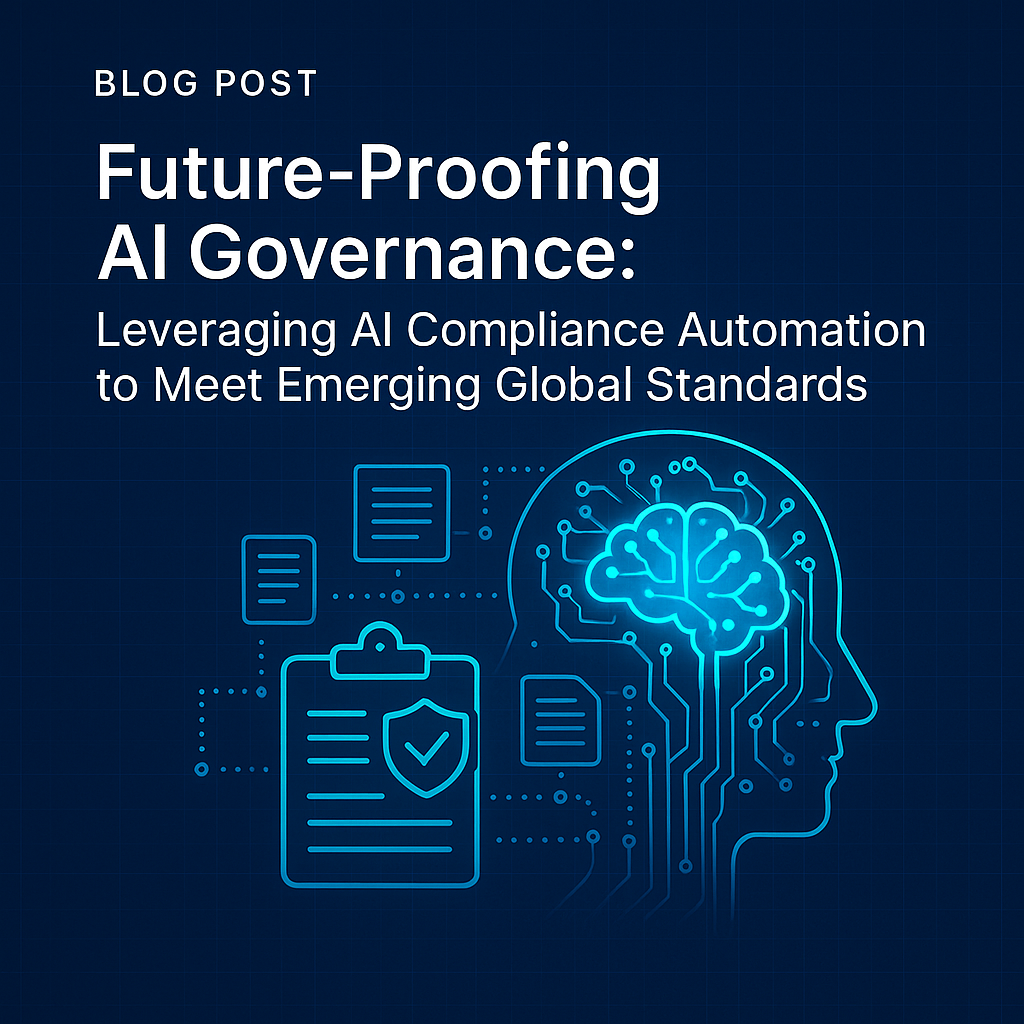Future-Proofing AI Governance: Leveraging AI Compliance Automation to Meet Emerging Global Standards

Introduction
As AI technologies proliferate across industries, regulators worldwide are racing to establish governance frameworks that ensure safety, transparency, and ethical use. From Ofcom’s safety-by-design vision in the UK to the European Data Protection Board’s new data-transfer guidelines, organizations face a complex tapestry of rules and recommendations [Ofcom publishes its vision for AI governance, 06-09][European Data Protection Board finalises new data-transfer rules, 06-09]. To stay audit-ready and resilient, you need a unified, proactive approach to AI governance.
The Global Wave of AI Governance Frameworks
- UK’s Ofcom Safety-by-Design: Emphasizes integrating safeguards early in AI development cycles, from bias testing to continuous monitoring [Ofcom publishes its vision for AI governance, 06-09].
- EU Data-Transfer Guidelines: Introduce specialized provisions for AI-focused training and cross-border data flows, demanding updated data-mapping controls [European Data Protection Board finalises new data-transfer rules, 06-09].
- Canada’s Greenwashing Enforcement: Expands compliance requirements under the Competition Act, affecting AI-driven ESG reporting [Canada’s Competition Bureau issues guidelines to combat greenwashing, 06-09].
- US OCC Modernization Agenda: Highlights fintech compliance modernization, requiring robust third-party AI risk assessments.
Challenges Presented by Fragmented Standards
Each regulatory initiative brings its own definitions, risk thresholds, and reporting cadences. The GRC Report “Reevaluating GRC: Beyond ROI to Real Business Impact” underscores how organizations can shift from perceiving GRC as a cost center to leveraging it as a driver of resilience and growth—provided they can harmonize diverse requirements into a single, actionable strategy [GRC Report: Reevaluating GRC: Beyond ROI to Real Business Impact, 06-09].
- Inconsistent Terminology: What one jurisdiction classifies as “high-risk AI” may differ in another, complicating policy standardization.
- Overlapping Controls: Dual reporting deadlines and contradictory audit scopes increase the burden on compliance teams.
- Manual Monitoring Burden: Reliance on spreadsheets and email alerts slows response times and elevates risk of oversight.
Role of AI Compliance Automation in Addressing AI Governance
Compliance. Accelerated by AI. Verified by Experts. This principle guides how modern GRC platforms transform fragmented governance into a cohesive, automated process.
- Continuous Horizon Scanning: AI-driven engines ingest and normalize updates from regulatory bodies around the clock.
- Automated Rule Normalization: Disparate definitions—such as “critical AI system”—are aligned into a unified taxonomy for your controls.
- Control Mapping & Gap Analysis: New or updated regulations are automatically mapped to your existing control library, highlighting coverage gaps and recommended actions.
- Expert Review Workflows: All AI-generated recommendations flow through human experts to ensure contextual accuracy before deployment.
Key Features to Look for in an AI-Driven GRC Platform
When evaluating solutions, focus on these capabilities:
- Regulatory Intelligence Library: Pre-built coverage of 900+ global AI governance frameworks and guidelines.
- Advanced Analytics Dashboard: Real-time risk heat maps, control-performance metrics, and compliance scorecards.
- Audit-Ready Evidence Repository: Automated collection of logs, policy documents, and test results, all tagged and timestamped for immediate auditor review.
- Seamless Integrations: Connect with development pipelines, cloud platforms, and data management tools to surface compliance findings at the point of change.
Best Practices for Building an AI-Ready Compliance Strategy
- Governance Alignment: Define clear roles and responsibilities for AI ownership, risk oversight, and compliance sign-off within your organization.
- Cross-Functional Collaboration: Engage legal, privacy, IT, and business units in co-creating policies and validating automated controls.
- Continuous Training: Provide regular workshops on AI governance terminology, emerging regulations, and platform capabilities.
- Proactive Auditing: Run simulated governance audits—covering bias checks, privacy impact assessments, and security reviews—to test end-to-end workflows.
Conclusion
Navigating the evolving landscape of AI governance requires more than reactive, manual processes. By embedding AI compliance automation into your GRC strategy, you can harmonize global standards, reduce manual effort by up to 70%, and maintain audit-ready assurance at every step. Future-proof your AI initiatives, drive business resilience, and turn compliance into a strategic advantage—today and tomorrow.
Stay Updated with Our Newsletter
Join our newsletter to receive the latest updates and insights from our blog. Stay informed about compliance trends and best practices.
